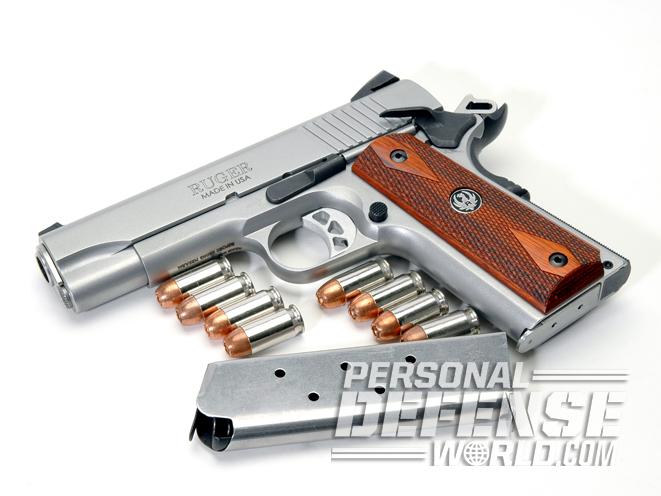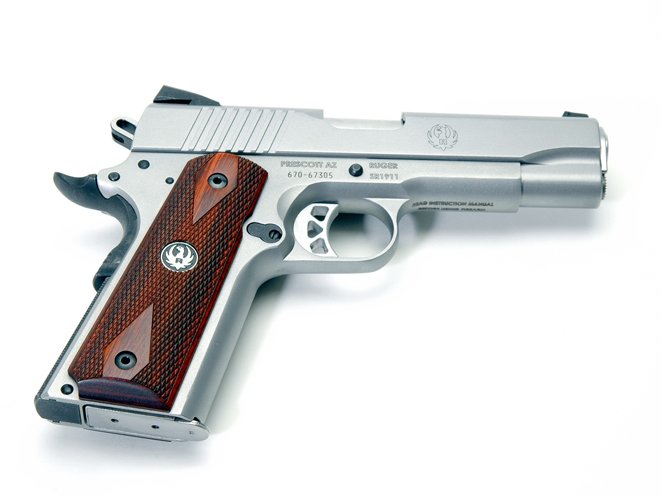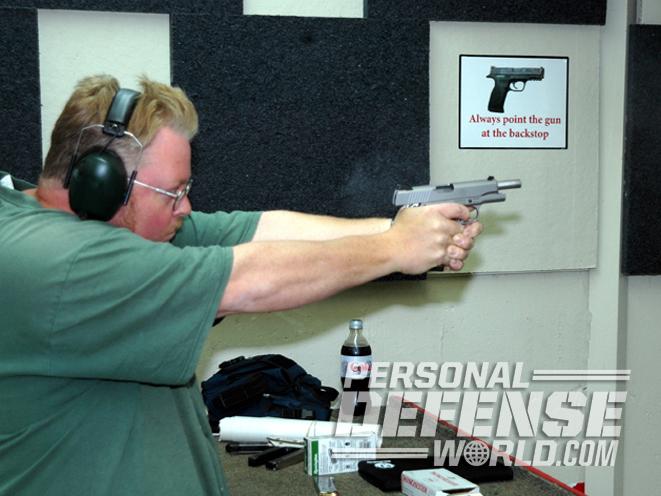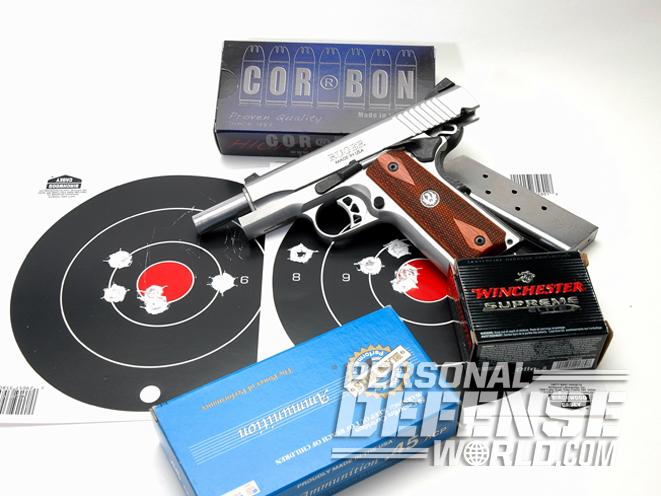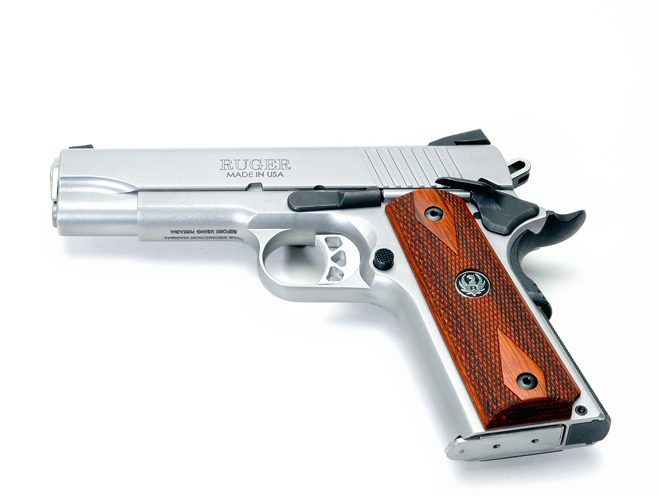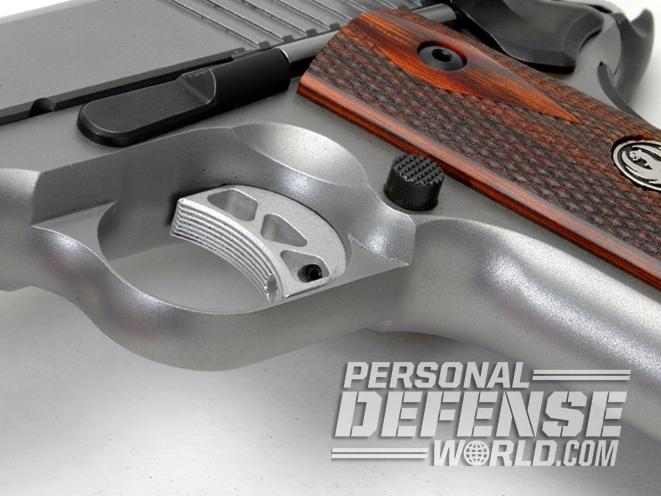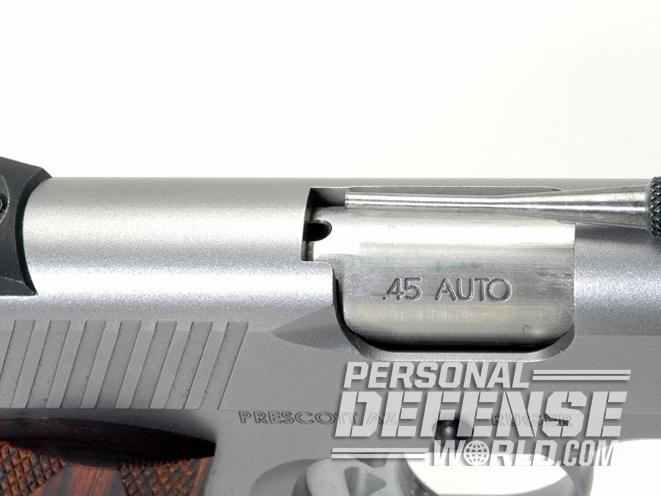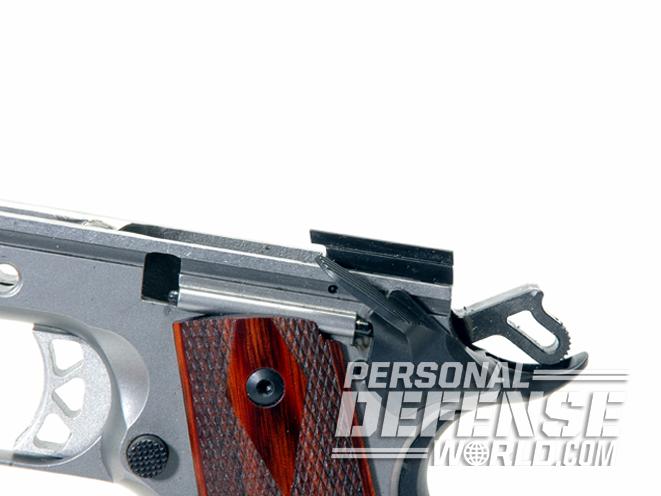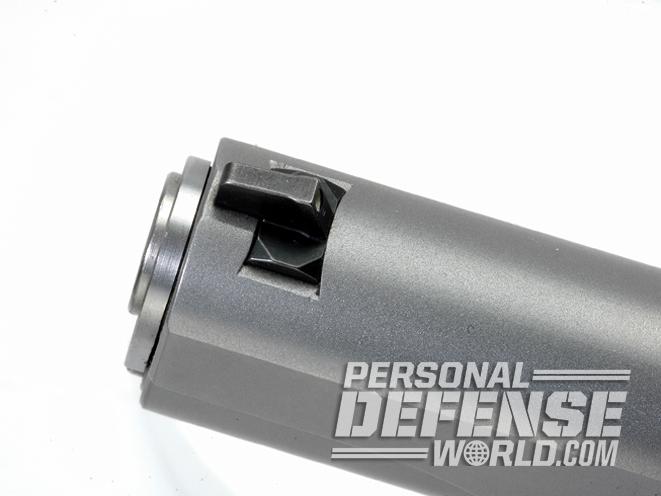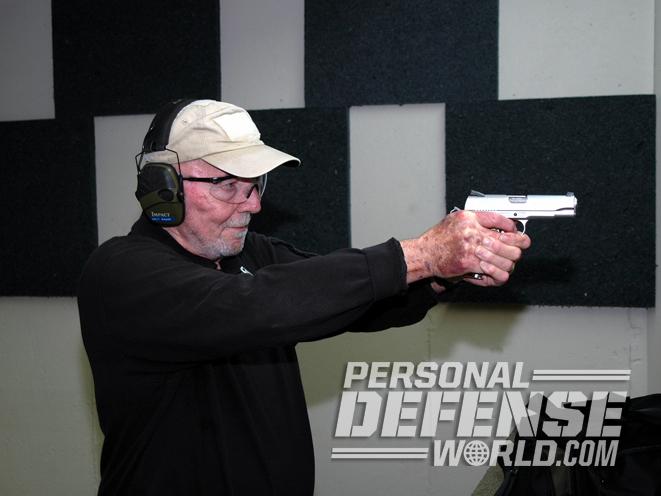After the success of the SR1911, it was a forgone conclusion that Ruger would eventually introduce a shorter version, and now the company has done just that with the SR1911CMD, which has a 4.25-inch barrel and a shortened slide to match compared to the full-sized SR1911’s 5-inch barrel.
Translating the SR1911CMD’s model designation, we seem to have Sturm Ruger 1911 Commander. Well, the “SR” part is understandable, but what about “CMD”? To understand that, we have to turn to Colt, which still holds the rights to the “Commander” name for its shortened and lightened 1911.
In 1947, when the U.S. military asked for a shorter and lighter 1911 that chambered the 9mm NATO cartridge, Colt delivered what would become the Commander. While the pistol passed all of its tests, the military decided against it. The U.S. was undergoing a post-war economizing of all things military, and they had more than enough 1911s for their needs. Colt, wanting to recover the costs of its effort, named the pistol “Commander” and took it to the open markets, where it was successful. Down the line, though, some potential buyers discovered that when you reduce a 1911’s weight from 38 or 39 ounces to 26 or 27 ounces and then touch off full-power .45 ACP, the gun has more felt recoil.
Advertisement — Continue Reading Below
Gun buyers still liked the shorter slide and barrel lengths but now wanted a heavier version. They also wanted a 1911 that didn’t rust as quickly as the blued carbon steel used in the Commander. Colt fixed these issues by using stainless steel and labeled the result the “Combat Commander.” Now, Ruger’s SR1911CMD pays homage to this very successful 1911 design while providing a concealment-ready option for civilian shooters.
Gun Details
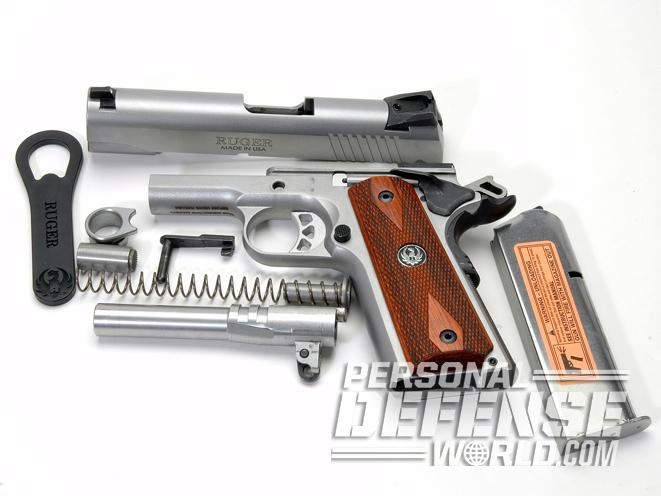
Advertisement — Continue Reading Below
The SR1911CMD configuration features what have become the expected dimensions of the original Colt Commander. The slide is CNC-machined from bar stock. For targeting, the pistol has Novak LoMount Carry sights set-up in the ubiquitous three-white-dot configuration, which help shooters get on target quickly. The front and rear sights are mounted in dovetail cuts in the slide, which allows for slight horizontal sighting corrections. The rear sight is further secured with an Allen screw in its body.
Eight forward-angled grasping grooves are at the rear of the slide. The ejection port is large, with a small groove trailing from the right center-rear of the opening. Both the larger port and this groove provide more room for the unhindered ejection of spent casings. The ejection port’s edges are slightly rounded, as are the entire slide’s lower edges. (Historically, many 1911s had somewhat sharp edges, as do some of today’s lower-cost offerings.) The right side of the slide bears the Ruger logo, while the left side has “Ruger” and “Made in USA” markings.
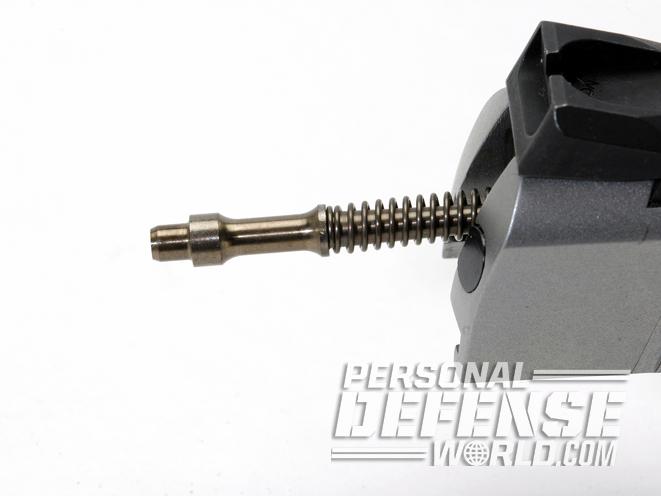
Advertisement — Continue Reading Below
The Ruger SR1911CMD utilizes a traditional internal extractor. The firing pin is made of titanium with a golden tint. By feel, it appears that a heavier-than-standard firing pin spring is used. The combination of the two has been found to forgo the need for a mechanical, passive firing-pin safety. Also, the SR1911CMD’s ejector has an extended ledge to aid in case ejection.
The barrel is nicely crowned, and the well-polished feed ramp is beveled from 4 to 8 o’clock. The solid barrel bushing is finger tight, so there is no need to use the supplied polymer bushing wrench for disassembly. The chamber hood is notched at the rear. This is done so that it is possible to see into the rear of the chamber, where part of a loaded cartridge case will be visible.
RELATED: Ruger Expands Its 9mm LC9s Lineup For 2015 | VIDEO
Advertisement — Continue Reading Below
The recoil spring plug is checkered on its face, and the pistol uses a standard recoil spring guide. I estimate the recoil spring has a 20-pound spring strength.
Moving on to the Ruger investment-cast frame, we find the obligatory safety warning of “Read Instruction Manual Before Using Firearm” (excellent advice) discreetly located on the bottom area of the dust cover. One interesting feature is that the plunger housing, which holds the driving spring and pins controlling the slide stop and manual safety, has been made integral to the frame. Historically, this part is pinned to the frame and can loosen after extended use. When this occurs, the usual result is, at the least, you cannot operate the thumb safety, or the slide locks open while firing. At worst, both occur at the same time and the gun stops working. If this happens, I know of no field-expedient measure that can overcome it.
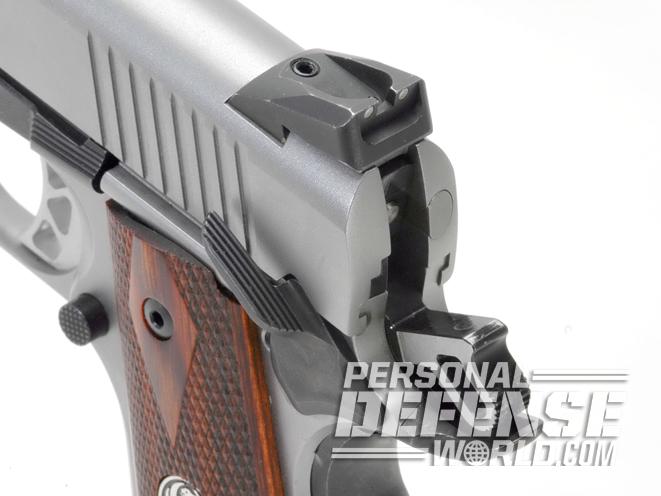
Advertisement — Continue Reading Below
The SR1911CMD’s parts are black in color. The slide stop and the extended, left-side-mounted thumb safety are grooved their entire lengths, with the safety moving smoothly with a firm click to the “on” and “off” positions. The beavertail grip safety, mainspring housing and magazine catch are also black. The face of the magazine catch and the mainspring housing are checkered. The catch is slightly taller, and the trigger body is a bit longer than standard.
The skeletonized, rounded hammer is blued on top and has grooves for easier thumb-cocking. It’s an attractive, functional enhancement. The sides of the hammer are polished but not blued. The long and grooved aluminum trigger has an overtravel screw. Out of the box, the trigger pull weight on my test gun measured 4.5 pounds, and it decreased to 4.25 pounds after breaking the gun in at the range.
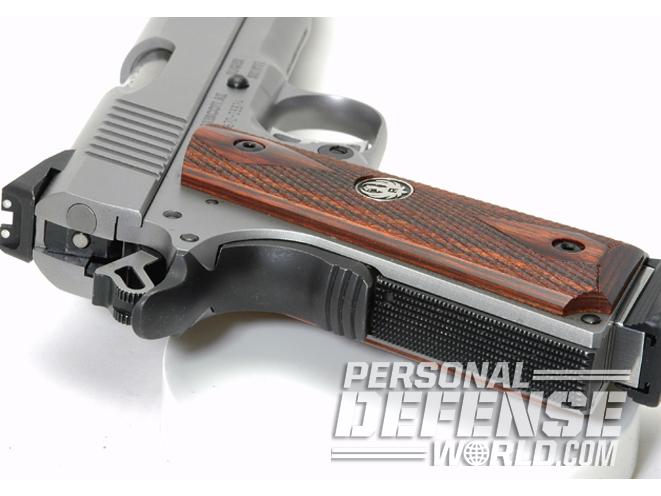
Advertisement — Continue Reading Below
While the SR1911CMD has a smooth frontstrap, the checkered, flat mainspring housing helps provide a secure grip. The beavertail grip safety has a raised, grooved “memory bump” which aids in fully depressing the safety when the gun is gripped. In addition to the beavertail configuration aiding in spreading felt recoil and allowing for a higher grip on the frame, the tail portion is sculpted inward on its sides. This subtle alteration allows you obtain an ever higher grip, and it’s most noticeable if you ride the thumb safety while shooting. The web of your hand moves slightly further forward and you get more hand behind the gun.
RELATED: Ruger’s New SR1911 Lightweight Commander | VIDEO
The grip panels are made of wood and sport the Ruger logo. They are nicely double-diamond-checkered and well secured by four Allen screws. The magazine well is slightly beveled on the sides and at the rear—something ignored by some brands. Ruger also removes the often sharp and annoying (if not sometimes downright painful) forward edges in the front area of the well.
Advertisement — Continue Reading Below
The SR1911CMD comes with two polished, stainless steel, seven-round magazines. Both have patented magazine followers and cartridge inspection holes on both sides of their bodies. Two holes are drilled into the non-removable baseplate for attaching a basepad.
Range Time

My friends Ted Murphy, AJ Stuart and Irv Gill helped me test the SR1911CMD at our local gun club, the Lower Providence Rod & Gun Club in Oaks, Pennsylvania. We shot the SR1911CMD the way it came, with no additional lubrication (this was an accident, as I simply forgot to apply any) and only very limited manipulation or dry firing. AJ started the shooting and fired five rounds without a problem when the omission of additional lube dawned on me. As the lack of it did not interfere with his shooting, we continued and experienced no malfunctions. The only negative my error caused was when retracting the slide, as it gave a gritty feeling to its movement. (Later, I added lube and this went away.)
Advertisement — Continue Reading Below
As to results, simply put, none of us were having a good day. There was certainly nothing wrong with the sights, as they gave a good sight picture and allowed for good sight alignment thanks to the 0.125-inch-wide front blade and the 0.14-inch notch of the rear sight. This combination highly favors quick sight acquisition as well.
We shot CorBon 230-grain Performance Match jacketed round nose (JRN), Black Hills 200-grain jacketed hollow point (JHP) and Winchester SXT 230-grain JHP ammunition. When well directed, which didn’t happen as often as we would have liked, the bullets went where they were aimed. But the results were certainly less than optimal for us.

At 17 yards, our best groups were unsatisfactory, particularly as we all had previously shot tight groups with the full-sized SR1911. On the plus side, watching Ted shoot full-power FMJ loads, the gun muzzle barely rose above horizontal. We also shot a bit off-hand (one- and two-handed) and made good hits, again with no malfunctions.
RELATED: Top 10 Compact 1911 Pistols For Concealed Carry Protection
On a subsequent range visit, I chronographed the test ammo and fired some five-shot groups at 25 yards. Now the two best groups measured 3 inches and 2.75 inches with Black Hills 200-grain JHPs and CorBon Performance Match 230-grain JRNs, respectively. All in all, the SR1911CMD is an excellent package, and it’s good to go right out of the box.
For more information, visit http://www.ruger.com.
